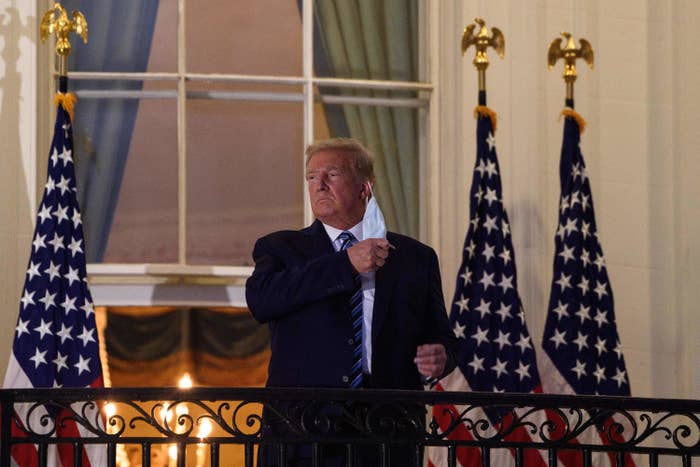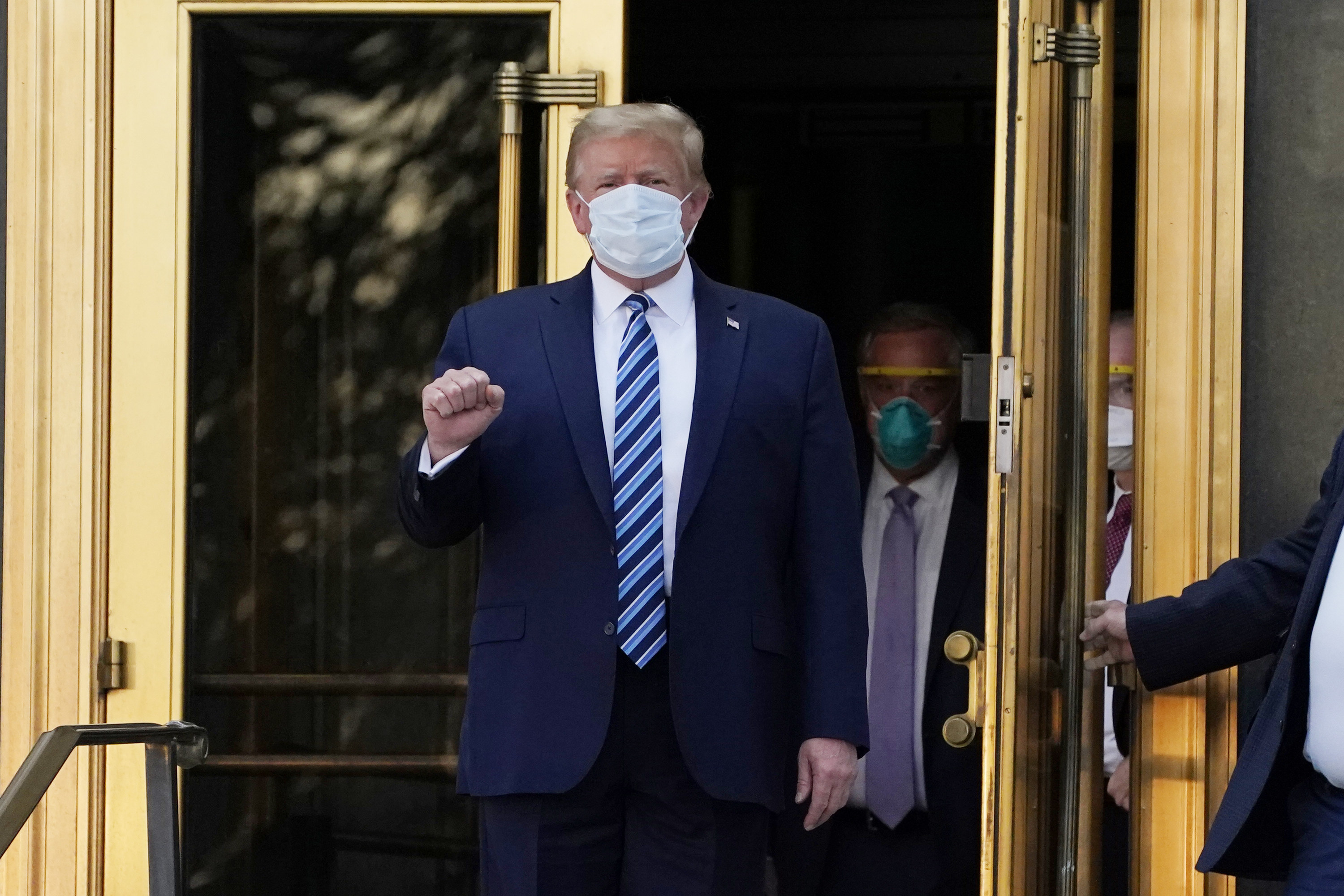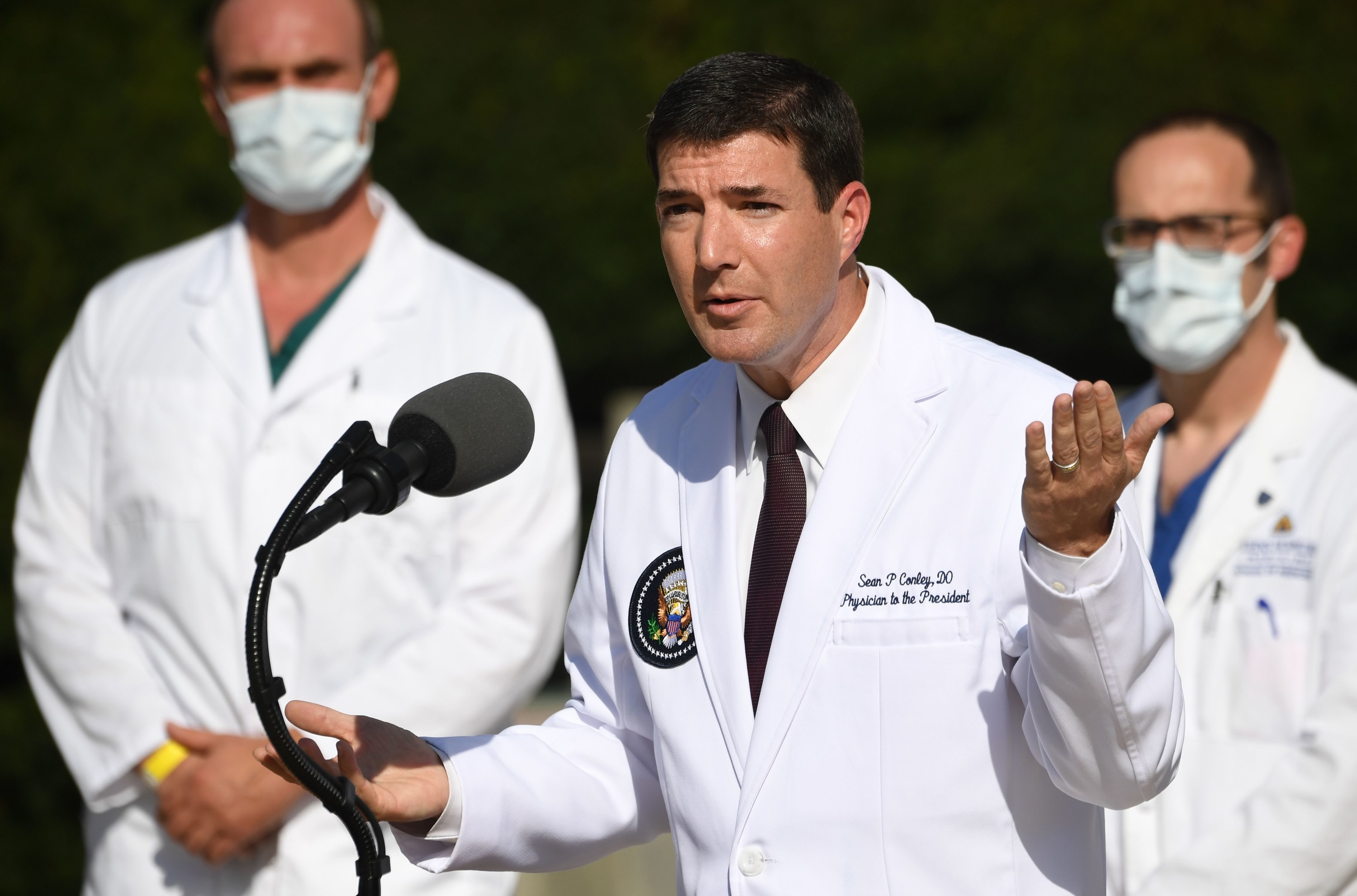
President Donald Trump returned to the White House on Monday, just hours after doctors admitted they are in "uncharted territory" because of the COVID-19 treatments he's received.
Trump did not respond to questions from reporters as he exited the hospital and got into an SUV, saying only "thank you very much" while giving an occasional thumbs-up.
Marine One touched down on the White House's South Lawn at around 6:54 p.m., after which Trump walked up the South Portico stairs, removed his face mask, and stood on the balcony overlooking the lawn for photos.
Not long after entering the White House, Trump posted a video message on Twitter, insisting, "I could have left two days ago. Two days ago I felt great, like better than I have in a long time."
He also reiterated his message of not letting the coronavirus "take over your lives" while defending his decision to relocate to the White House.
"I know there's a risk, there's a danger, but that's OK," he said. "And now I'm better, and maybe I'm immune, I don't know."
Trump’s doctors justified his departure on Monday after the president tweeted from Walter Reed National Military Medical Center that people should not “be afraid of Covid” or let it “dominate your life,” referring to a disease that has killed more than 210,000 Americans and more than 1 million people worldwide.
Physician Sean Conley, who has delivered a series of muddled and contradictory statements about the president’s health in recent days, claimed that his patient “met or exceeded all standard hospital discharge criteria.”
I will be leaving the great Walter Reed Medical Center today at 6:30 P.M. Feeling really good! Don’t be afraid of Covid. Don’t let it dominate your life. We have developed, under the Trump Administration, some really great drugs & knowledge. I feel better than I did 20 years ago!
However, Conley's comment seemed to defy signs that Trump's case of COVID-19 may in fact be severe. Over the weekend, Conley disclosed that Trump’s oxygen levels had dropped at least twice and that he’d been prescribed a steroid that the National Institutes of Health has said is recommended for only severe cases of COVID-19. In addition, clinical knowledge suggests that infections can rapidly intensify in the second week of illness.
Conley ducked questions about whether chest scans showed damage to the president’s lungs and when he had last tested negative for COVID-19, which would help establish where Trump is in the course of his illness.
At several turns, the physician declined to answer because he said the information was confidential under patient privacy laws — even though he relayed positive updates about the president’s health.
Conley said no doctors caring for the president or White House staffers voiced concerns about Trump returning home on Monday.

Brian Garibaldi, another doctor treating Trump, said the president will receive a fourth dose of the antiviral drug remdesivir this evening before being discharged and will receive the fifth dose at home, in addition to continuing to receive the steroid, dexamethasone.
For Trump to leave less than 72 hours after being hospitalized runs the risk of being discharged just when his illness could ramp up most dangerously.
Even as Trump was preparing to board Marine One on Monday, he tweeted: "Will be back on the Campaign Trail soon!!!"
But the CDC has warned that some patients can rapidly deteriorate a week after their illness starts.
“That's why we all remain cautiously optimistic and on guard, because we're in a bit of uncharted territory when it comes to a patient that received the therapies he has so early in the course,” said Conley, who said the president would be surrounded by “24/7 world-class medical care” in the White House. “We're looking to this weekend. If we can get through to Monday with him remaining the same or improving, better yet, then we will all take that final deep sigh of relief.”
Asked whether the president had neurological issues from his illness or medications, Conley denied that there were any, replying, “He’s back.”
Medical experts told BuzzFeed News that even if Trump is feeling well enough right now to go home, that may not last.
Krutika Kuppalli, an infectious diseases physician at the Medical University of South Carolina, said she found the decision to discharge “curious” and potentially concerning. She has had patients with COVID-19 who were seemingly doing well before suddenly deteriorating around day seven. “I would be worried that he hasn’t hit the point in his illness where that could happen,” she said, conceding that “this is difficult to know since there is a lot we have not been told about his illness."
Megan Ranney, an emergency medicine physician and researcher at Brown University, said that doctors generally try to discharge patients once their vital signs and laboratory tests have normalized. But that is not normally an option for patients receiving remdesivir, which is administered intravenously. “This is just an unprecedented situation and a really tough judgment call to make,” she said.
She added that it is uncommon for a person to get sick as quickly as Trump did. “The thing that makes me concerned isn’t that they’re discharging him so quickly — it’s that the worst is potentially yet to come,” she said.
The doctors also noted that, for Trump, going home is by no means equivalent to most people’s experience going home from the hospital. In the White House, he will have unusual access to care and constant monitoring. As Ranney put it, he is “having the most VIP of VIP treatments.”
While the president may be clear to go home, that doesn’t mean he has a green light health-wise to hit the campaign trail.
“We need to remember he’s still a patient,” said Carlos del Rio, an infectious disease expert at Emory University. “He’s still infectious. He needs to be in isolation for a total of 10 days after the diagnosis.”
The president is one of a growing cluster of at least 14 politicians and White House staffers who were infected with the virus. Just hours before his tweet, White House press secretary Kayleigh McEnany confirmed she too tested positive for COVID-19.
Although it is not known when exactly Trump was first infected, he is likely to still be in the earlier stages of the disease, given that he tested positive on Thursday.
Infection from SARS-CoV-2 consists of roughly three stages. First is the virus’s incubation period, in which the infected person doesn’t show any symptoms, which typically lasts from four to five days but sometimes up to 14. Next is the stage in which the virus is detectable and the person experiences symptoms, such as fever and cough.
For those who don’t recover at that point, the virus can then cause severe respiratory problems that may require supplemental oxygen or ventilation. The immune system can go into overdrive, at worst creating a “cytokine storm” that spirals out of control and sends immune cells to attack vital organs such as the lungs.
Since checking into Walter Reed Medical Center on Friday night, Trump, his White House staff, and Conley have blanketed the airwaves with contradictory messages about the state of the president’s health.
In a series of videos tweeted out from the hospital, Trump has repeatedly insisted that he is doing well. An anonymous source told reporters Saturday that the president’s vitals were “very concerning” — and then, when media outlets revealed that source to be White House chief of staff Mark Meadows, the staffer said on the record that “doctors are pleased with his vital signs.”
At back-to-back press conferences over the weekend, Conley maintained a relentlessly positive tone as he ducked key questions about his patient’s health. He described Trump on Saturday as having mild symptoms (“a mild cough and some nasal congestion and fatigue”), then on Sunday as having “continued to improve.” It was then that the president’s medical team said that Trump could be discharged as soon as the following day.
Despite the doctor’s cheerful portrayal — an attempt to “reflect the upbeat attitude” of the president, Conley admitted under questioning Sunday — there were a few clear signs that Trump’s condition was worsening rather than improving.

Conley announced Sunday he’d prescribed him dexamethasone, which has been shown to reduce the chance of death when given to patients with severe to critical COVID-19. But a large study in June showed that the drug provided no benefit to patients without a severe case and could even be harmful.
The president is also taking the antiviral drug remdesivir, which is authorized for emergency use, and has taken an even more experimental antibody cocktail, made by the company Regeneron. “I know of no one else in the world who has received all three of these medications together,” Ranney said. “Could it be a good thing? Yes. But could it be a bad thing? Yes. With VIP medicine we know that we often overtreat, and overtreatments can cause problems.”
Also Sunday, Conley admitted Trump had twice required additional oxygen after experiencing “two episodes of transient drops.” Asked whether Trump’s oxygen levels had ever dipped below 90, Conley would only say that it hadn’t dropped into “the low 80s or anything.” A healthy person’s oxygen level is in the high 90s.
Trump has claimed that having the virus has suddenly given him a new understanding of its effects.
“It’s been a very interesting journey,” he said in a video posted to Twitter on Sunday. “I learned a lot about COVID. I learned it by really going to school. This is the real school. This isn't the 'let's read the books' school.” He added, “And I get it, and I understand it, and it's a very interesting thing, and I’m going to be letting you know about it."
Shortly afterward, the president drove past supporters waiting outside the hospital in a cloth mask and a sealed-up SUV, an unexpected move that potentially put the drivers and security staff at risk.
First lady Melania Trump, who also tested positive for COVID-19, is still recovering at the White House. “I am feeling good & will continue to rest at home,” she tweeted Monday.
Correction: Dr. Brian Garibaldi was the doctor who spoke about Trump's dose of the antiviral drug remdesivir. A previous version of this story misattributed these comments to another doctor.

